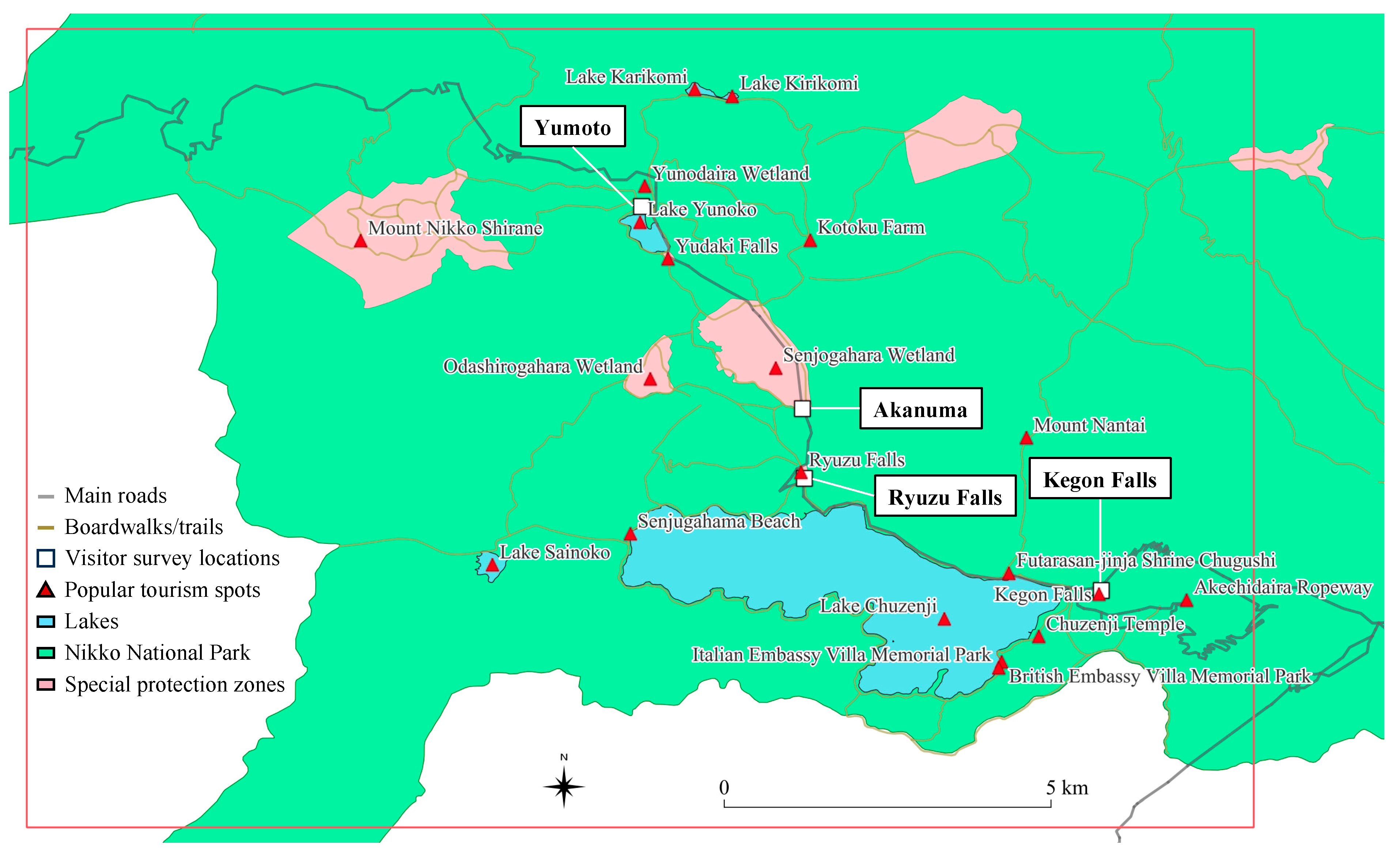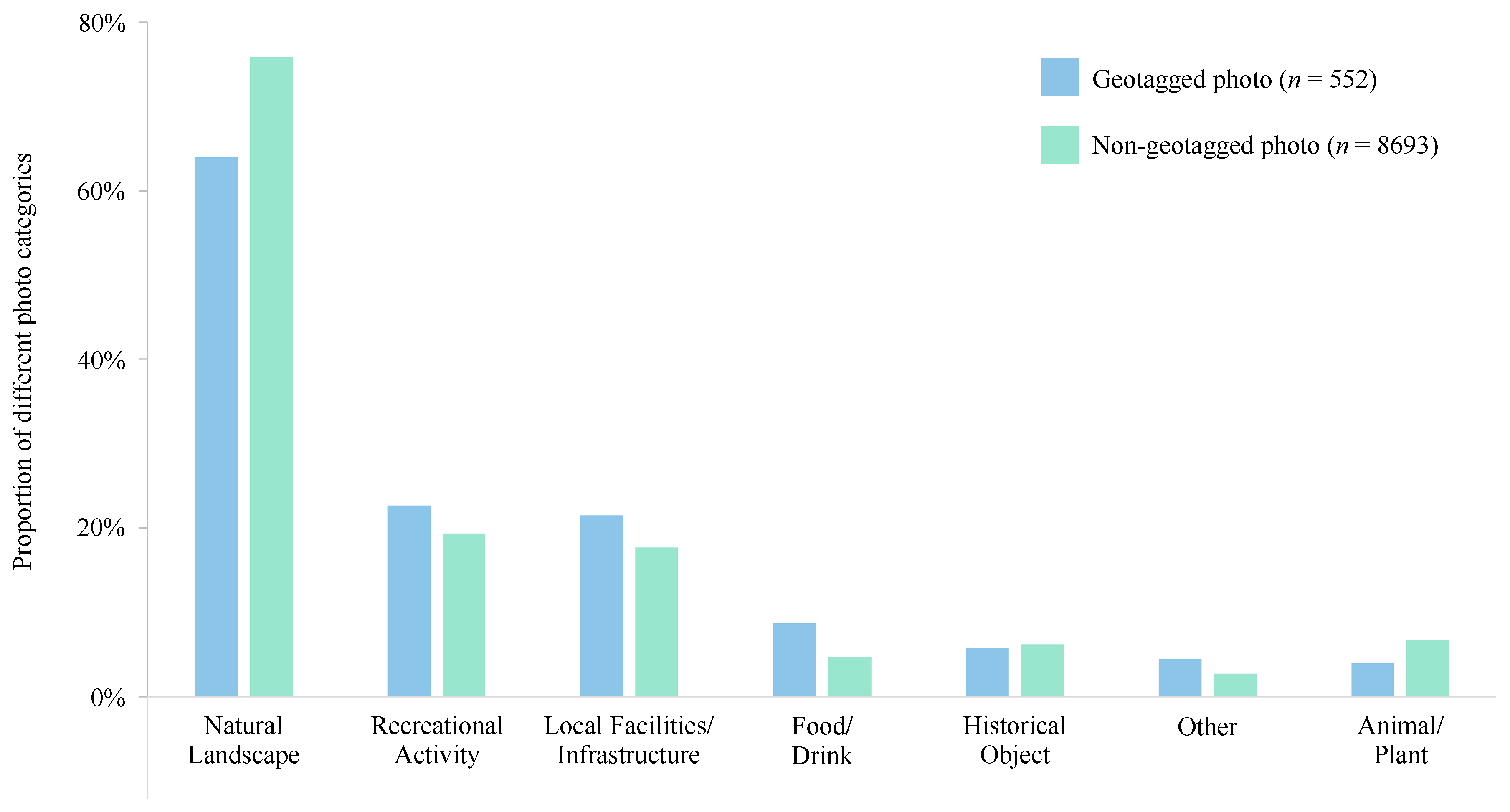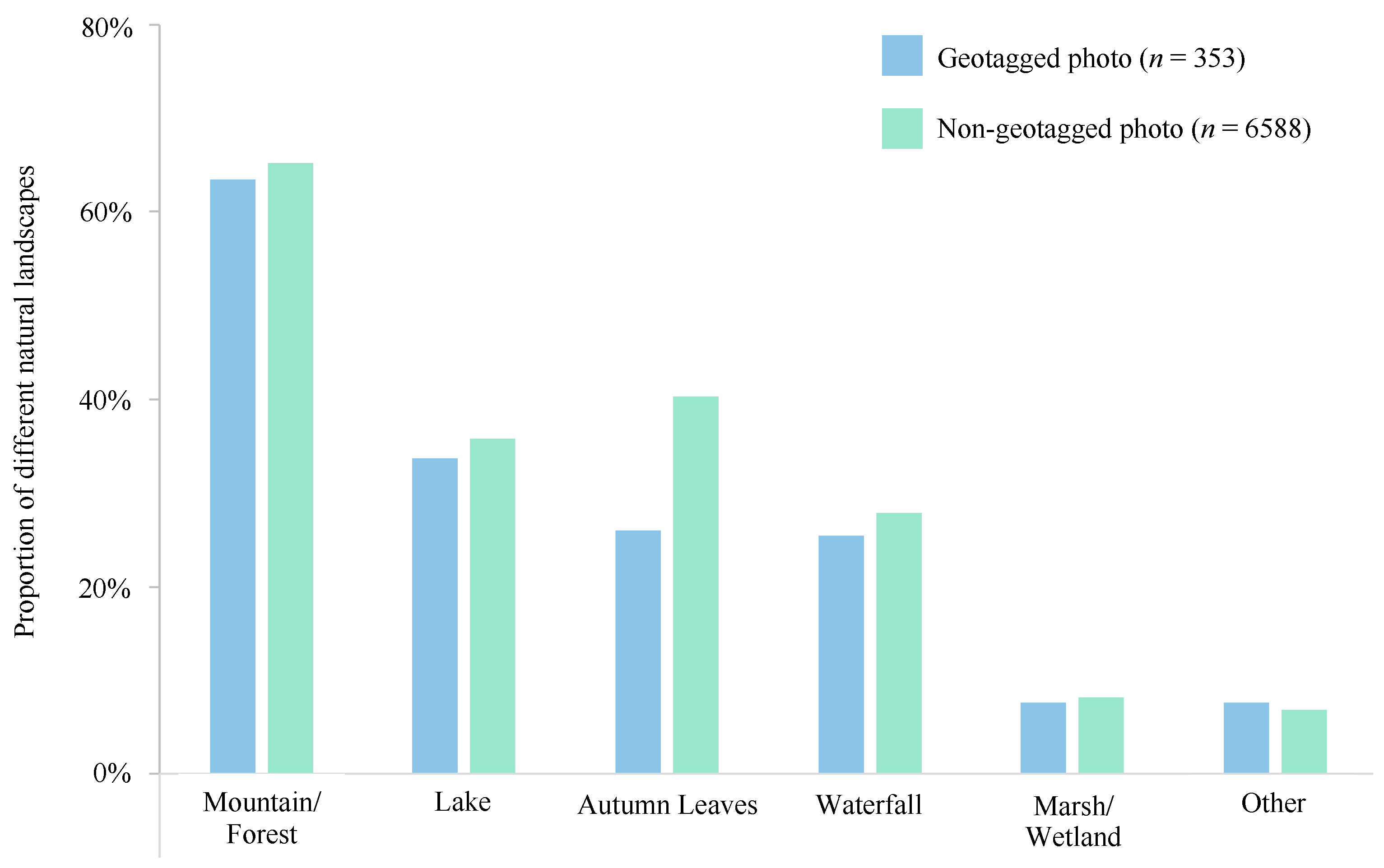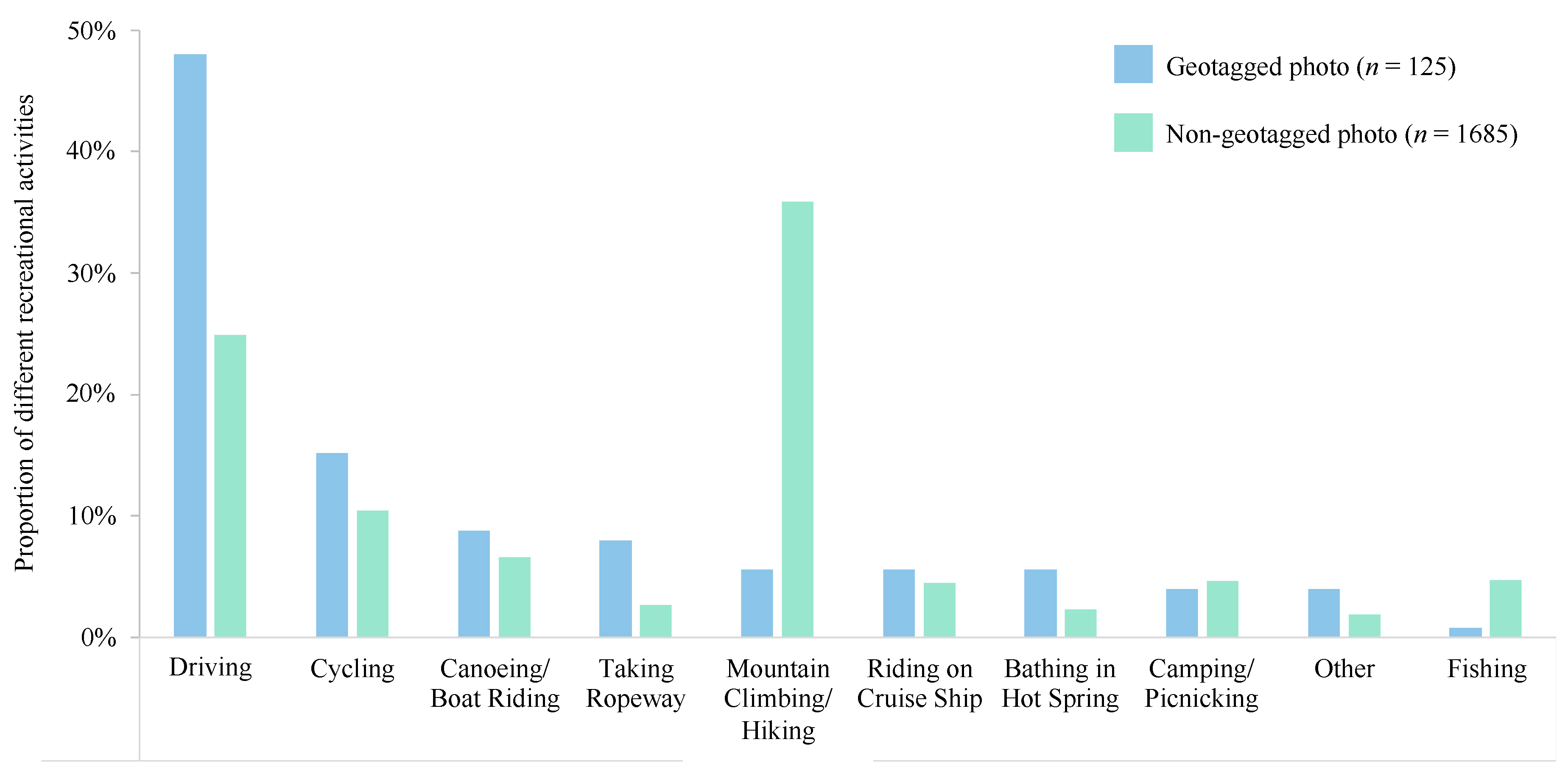Effectiveness of Non-Geotagged Social Media Data for Monitoring Visitor Experience in a National Park in Japan
Abstract
1. Introduction
2. Materials and Methods
2.1. Study Area
2.2. Visitor Survey
2.2.1. Data Collection
2.2.2. Statistical Analysis
2.3. Social Media Data
2.3.1. Data Source and Photo Collection
2.3.2. Photo Content Analysis
3. Results
3.1. Visitor Survey Data
3.1.1. Relationship between Geotag Usage and Visitor Attributes
3.1.2. Reasons for Using or Not Using Geotags on Social Media
3.2. Social Media Data
3.2.1. Geotagged and Non-Geotagged Photo Content
3.2.2. Biodiversity and Landscape Captured by Geotagged and Non-Geotagged Photos
4. Discussion
4.1. Differences in Visitor Attributes between Geotagged and Non-Geotagged Social Media Users
4.2. Differences in Photo Content between Geotagged and Non-Geotagged Data
4.3. Implications
4.4. Challenges
5. Conclusions
Author Contributions
Funding
Institutional Review Board Statement
Informed Consent Statement
Data Availability Statement
Acknowledgments
Conflicts of Interest
References
- Dudley, N. Guidelines for Applying Protected Area Management Categories; IUCN: Gland, Switzerland, 2008. [Google Scholar]
- Puhakka, R.; Pitkanen, K.; Siikamaki, P. The health and well-being impacts of protected areas in Finland. J. Sustain. Tour. 2017, 25, 1830–1847. Available online: http://www.nejm.org/doi/abs/10.1056/NEJM199812103392401 (accessed on 26 October 2023). [CrossRef]
- Wolf, I.D.; Wohlfart, T. Walking, hiking and running in parks: A multidisciplinary assessment of health and well-being benefits. Landsc. Urban Plan. 2014, 130, 89–103. [Google Scholar] [CrossRef]
- Nord, M.; Luloff, A.E.; Bridger, J.C. The association of forest recreation with environmentalism. Environ. Behav. 1998, 30, 235–246. [Google Scholar] [CrossRef]
- Steven, R.; Castley, J.G.; Buckley, R. Tourism revenue as a conservation tool for threatened birds in protected areas. PLoS ONE 2013, 8, 1–8. [Google Scholar] [CrossRef] [PubMed]
- Ma, A.T.; Lam, T.W.; Cheung, L.T.; Fok, L. Protected areas as a space for pandemic disease adaptation: A case of COVID-19 in Hong Kong. Landsc. Urban Plan. 2021, 207, 103994. [Google Scholar] [CrossRef]
- Pickering, C.M.; Hill, W. Impacts of recreation and tourism on plant biodiversity and vegetation in protected areas in Australia. J. Environ. Manag. 2007, 85, 791–800. [Google Scholar] [CrossRef]
- Ranaweerage, E.; Ranjeewa, A.D.G.; Sugimoto, K. Tourism-induced disturbance of wildlife in protected areas: A case study of free ranging elephants in Sri Lanka. Glob. Ecol. Conserv. 2015, 4, 625–631. [Google Scholar] [CrossRef]
- Wang, T.; Watanabe, T. Impact of recreational activities on an unmanaged alpine campsite: The case of Kuro-dake Campsite, Daisetsuzan National Park, Japan. Environments 2019, 6, 34. [Google Scholar] [CrossRef]
- Hausmann, A.; Toivonen, T.; Slotow, R.; Tenkanen, H.; Moilanen, A.; Heikinheimo, V.; Di Minin, E. Social media data can be used to understand tourists’ preferences for nature-based experiences in protected areas. Conserv. Lett. 2018, 11, e12343. [Google Scholar] [CrossRef]
- Heikinheimo, V.; Minin, E.D.; Tenkanen, H.; Hausmann, A.; Erkkonen, J.; Toivonen, T. User-generated geographic information for visitor monitoring in a national park: A comparison of social media data and visitor survey. ISPRS Int. J. Geo-Inf. 2017, 6, 85. [Google Scholar] [CrossRef]
- McCarthy, D.P.; Donald, P.F.; Scharlemann, J.P.W.; Buchanan, G.M.; Balmford, A.; Green, J.M.H.; Bennun, L.A.; Burgess, N.D.; Fishpool, L.D.C.; Garnett, S.T.; et al. Financial costs of meeting global biodiversity conservation targets: Current spending and unmet needs. Science 2012, 338, 946–949. [Google Scholar] [CrossRef]
- Longley, P.A.; Adnan, M.; Lansley, G. The geotemporal demographics of twitter usage. Environ. Plan. A 2015, 47, 465–484. [Google Scholar] [CrossRef]
- Di Minin, E.; Tenkanen, H.; Toivonen, T. Prospects and challenges for social media data in conservation science. Front. Environ. Sci. 2015, 3, 1–6. [Google Scholar] [CrossRef]
- Tenkanen, H.; Di Minin, E.; Heikinheimo, V.; Hausmann, A.; Herbst, M.; Kajala, L.; Toivonen, T. Instagram, Flickr, or Twitter: Assessing the usability of social media data for visitor monitoring in protected areas. Sci. Rep. 2017, 7, 17615. [Google Scholar] [CrossRef]
- Toivonen, T.; Heikinheimo, V.; Fink, C.; Hausmann, A.; Hiippala, T.; Järv, O.; Tenkanen, H.; Di Minin, E. Social media data for conservation science: A methodological overview. Biol. Conserv. 2019, 233, 298–315. [Google Scholar] [CrossRef]
- Sui, D.; Goodchild, M. The convergence of GIS and social media: Challenges for GIScience. Int. J. Geogr. Inf. Sci. 2011, 25, 1737–1748. [Google Scholar] [CrossRef]
- Richards, D.R.; Friess, D.A. A rapid indicator of cultural ecosystem service usage at a fine spatial scale: Content analysis of social media photographs. Ecol. Indic. 2015, 53, 187–195. [Google Scholar] [CrossRef]
- Institute for Information and Communications Policy. Research on Attitudes toward the Use of Location Information. 2014. Available online: https://www.soumu.go.jp/iicp/chousakenkyu/data/research/survey/telecom/2014/location-info.pdf (accessed on 26 October 2023).
- Komossa, F.; Wartmann, F.M.; Kienast, F.; Verburg, P.H. Comparing outdoor recreation preferences in peri-urban landscapes using different data gathering methods. Landsc. Urban Plan. 2020, 199, 103796. [Google Scholar] [CrossRef]
- Ministry of the Environment. Data on the Protection of the Natural Environment. 2019. Available online: http://www.env.go.jp/park/doc/data.html (accessed on 26 October 2023).
- Landis, J.R.; Koch, G.G. The measurement of observer agreement for categorical data. Biometrics 1977, 33, 159. [Google Scholar] [CrossRef]
- Birenboim, A.; Shoval, N. Mobility research in the age of the smartphone. Ann. Am. Assoc. Geogr. 2016, 106, 283–291. [Google Scholar] [CrossRef]
- Miyasaka, T.; Oba, A.; Akasaka, M.; Tsuchiya, T. Sampling limitations in using tourists’ mobile phones for GPS-based visitor monitoring. J. Leis. Res. 2018, 49, 298–310. [Google Scholar] [CrossRef]
- Maaß, W. The elderly and the internet: How senior citizens deal with online privacy. In Privacy Online Perspectives on Privacy and Self-Disclosure in the Social Web; Trepte, S., Reinecke, L., Eds.; Springer: Berlin/Heidelberg, Germany, 2011. [Google Scholar]
- Van den Broeck, E.; Poels, K.; Walrave, M. Older and wiser? Facebook use, privacy concern, and privacy protection in the life stages of emerging, young, and middle adulthood. Soc. Media + Soc. 2015, 1, 1–11. [Google Scholar] [CrossRef]
- National Police Agency. Circumstances of Juvenile Delinquency, Child Abuse, and Sexual Abuse of Children in 2021. 2022. Available online: https://www.npa.go.jp/bureau/safetylife/syonen/pdf-r3-syonenhikoujyokyo.pdf (accessed on 26 October 2023).
- Kanoh, H.; Kozaki, K.; Hasegawa, M.; Hishida, T. Development of ontology for information literary. Procedia Comput. Sci. 2015, 60, 170–177. [Google Scholar] [CrossRef][Green Version]
- Ministry of Internal Affairs and Communications. White Paper 2014: Information and Communications in Japan. 2014. Available online: https://www.soumu.go.jp/johotsusintokei/whitepaper/eng/WP2014/2014-index.html (accessed on 26 October 2023).
- Ministry of Internal Affairs and Communications. White Paper 2020: Information and Communications in Japan. 2020. Available online: https://www.soumu.go.jp/johotsusintokei/whitepaper/eng/WP2020/2020-index.html (accessed on 26 October 2023).
- Ghermandi, A.; Sinclair, M. Passive crowdsourcing of social media in environmental research: A systematic map. Glob. Environ. Chang. 2019, 55, 36–47. [Google Scholar] [CrossRef]
- Kajikawa, M.; Miyasaka, T.; Kubota, Y.; Oba, A.; Miyasaka, K. Quantifying nationality bias in social media data on different platforms for visitor monitoring in Nikko National Park, Japan. Geogr. Pannonica 2023, 27, 228–238. [Google Scholar]
- Soga, M.; Gaston, K.J. Extinction of experience: The loss of human-nature interactions. Front. Ecol. Environ. 2016, 14, 94–101. [Google Scholar] [CrossRef]
- Bixler, R.D.; Floyd, M.F.; Hammitt, W.E. Environmental socialization: Quantitative tests of the childhood play hypothesis. Environ. Behav. 2002, 34, 795–818. [Google Scholar] [CrossRef]
- Thompson, C.; Aspinall, P.; Montarzino, A. The childhood factor: Adult visits to green places and the significance of childhood experience. Environ. Behav. 2008, 40, 111–143. [Google Scholar] [CrossRef]
- Ministry of Internal Affairs and Communications. 2011 Survey on Time Use and Leisure Activities in Japan. 2013. Available online: https://www.stat.go.jp/english/data/shakai/2011/pdf/activities.pdf (accessed on 26 October 2023).
- Huai, S.; Chen, F.; Liu, S.; Canters, F.; Van de Voorde, T. Using social media photos and computer vision to assess cultural ecosystem services and landscape features in urban parks. Ecosyst. Serv. 2022, 57, 101475. [Google Scholar] [CrossRef]






| Fixed Effect | All Visitors (Japanese and International) | Only Japanese Visitors | |||
|---|---|---|---|---|---|
| Odds Ratio | 95% CI | Odds Ratio | 95% CI | ||
| Intercept | 0.241 | 0.078–0.748 | 0.348 | 0.113–1.075 | |
| Attribute | Gender (male, 0; female, 1) | 0.817 | 0.505–1.321 | 0.679 | 0.398–1.158 |
| Age group | |||||
| 10s | 1.781 | 0.456–6.956 | 1.264 | 0.275–5.816 | |
| 20s | 1.999 | 0.853–4.685 | 1.816 | 0.713–4.628 | |
| 30s | 3.360 | 1.380–8.183 | 3.378 | 1.243–9.181 | |
| 40s | 3.589 | 1.433–8.987 | 2.956 | 1.104–7.916 | |
| 50s | 1.505 | 0.638–3.550 | 1.389 | 0.562–3.432 | |
| Place of residence | 3.705 | 1.821–7.539 | |||
| (Japan, 0; international, 1) | |||||
| Frequency of visit | 0.998 | 0.565–1.761 | 0.807 | 0.430–1.512 | |
| (first-time, 0; repeat, 1) | |||||
| Length of stay | 1.479 | 0.927–2.360 | 1.232 | 0.740–2.053 | |
| (day trip, 0; overnight trip, 1) | |||||
| Social media used | Twitter (not use, 0; use, 1) | 0.995 | 0.600–1.650 | 0.793 | 0.460–1.368 |
| Instagram (not use, 0; use, 1) | 1.581 | 0.929–2.691 | 1.717 | 0.956–3.086 | |
| Facebook (not use, 0; use, 1) | 1.310 | 0.809–2.121 | 1.563 | 0.918–2.661 | |
| Answer | Number of Respondents |
|---|---|
| It helps me remember where I have been and what I did there | 60 |
| It enables me to share my travel experiences with someone more clearly | 39 |
| Do not have a particular reason | 29 |
| It enables me to tell someone clearly which places I recommend | 26 |
| Other | 23 |
| No response given | 15 |
| Answer | Number of Responses |
|---|---|
| Do not have a particular reason | 49 |
| Privacy concerns | 49 |
| Do not know how to use geotags | 19 |
| Not necessary | 10 |
| Too much work to set it up | 9 |
| Use text including hashtags to show where I visit instead of geotags | 8 |
| Concerned about limited battery life | 3 |
| Do not want the habitat of wild birds to be identified | 3 |
| Other | 6 |
| No response given | 15 |
| Classification | Species | Number of Geotagged Photos | Number of Non-Geotagged Photos |
|---|---|---|---|
| Mammal | Macaca fuscata | 3 (1) | 10 (6) |
| Cervus nippon | 2 (2) | 12 (10) | |
| Felis silvestris catus | 0 | 4 (3) | |
| Ursus thibetanus japonicus | 0 | 2 (2) | |
| Martes melampus | 0 | 1 | |
| Bird | Anas spp. | 0 | 11 (11) |
| Saxicola torquata | 0 | 10 (5) | |
| Sitta europaea | 0 | 6 (3) | |
| Dendrocopos leucotos | 0 | 5 (3) | |
| Uragus sibiricus | 0 | 3 (3) | |
| Haliaeetus pelagicus | 0 | 2 (2) | |
| Podiceps nigricollis | 0 | 2 (1) | |
| Lanius bucephalus | 0 | 2 (1) | |
| Tarsiger cyanurus | 0 | 2 (1) | |
| Pyrrhula pyrrhula | 0 | 1 | |
| Aegithalos caudatus | 0 | 1 | |
| Carpodacus roseus | 0 | 1 | |
| Phalacrocorax carbo | 0 | 1 | |
| Cinclus pallasii | 0 | 1 | |
| Regulus regulus | 0 | 1 | |
| Streptopelia orientalis | 0 | 1 | |
| Motacilla cinerea | 0 | 1 | |
| Certhia familiaris | 0 | 1 | |
| Parus minor | 0 | 1 | |
| Motacilla alba | 0 | 1 | |
| Anthus hodgsoni | 0 | 1 | |
| Kaniska canace | 0 | 1 | |
| Other | 0 | 2 (1) | |
| Insect | Dragonfly | 0 | 9 (8) |
| Other | 0 | 3 (2) | |
| Fish | Salvelinus fontinalis | 0 | 14 (9) |
| Oncorhynchus nerka | 0 | 7 (3) | |
| Salvelinus namaycush | 0 | 6 (3) | |
| Oncorhynchus mykiss | 0 | 4 (3) | |
| Salmo trutta | 0 | 1 | |
| Hypomesus nipponensis | 0 | 1 | |
| Other | 0 | 5 (5) | |
| Visitor’s pet | Canis lupus familiaris | 0 | 22 (11) |
| Museum exhibit | Cryptobranchoidea sp. | 0 | 1 |
| Classification | Species | Number of Geotagged Photos | Number of Non-Geotagged Photos |
|---|---|---|---|
| Tree | Acer spp. | 5 (5) | 195 (155) |
| Betula platyphylla | 1 (1) | 25 (22) | |
| Sorbus commixta | 0 | 17 (16) | |
| Pinus spp. | 0 | 6 (6) | |
| Cunninghamia lanceolata | 0 | 1 | |
| Malus baccata var. mandshurica | 0 | 1 | |
| Rubus crataegifolius | 0 | 1 | |
| Herb | Gentiana scabra var. buergeri | 0 | 10 (5) |
| Phragmites australis | 0 | 7 (6) | |
| Swertia bimaculata | 0 | 7 (5) | |
| Spiraea salicifolia | 0 | 6 (3) | |
| Geranium yesoense var. nipponicum | 0 | 4 (3) | |
| Aster ageratoides Turcz. var. ageratoides | 0 | 3 (2) | |
| Parnassia palustris | 0 | 3 (2) | |
| Leucosceptrum japonicum | 0 | 3 (1) | |
| Solidago virgaurea var. asiatica | 0 | 2 (2) | |
| Adenophora takedae | 0 | 1 | |
| Aster microcephalus var. ovatus | 0 | 1 | |
| Cimicifuga simplex | 0 | 1 | |
| Cirsium oligophyllum var. nikkoense | 0 | 1 | |
| Cirsium purpuratum | 0 | 1 | |
| Impatiens noli-tangere | 0 | 1 | |
| Maianthemum dilatatum | 0 | 1 | |
| Ranunculus nipponicus var. submersus | 0 | 1 | |
| Scirpus wichurae | 0 | 1 | |
| Tricyrtis latifolia f. nikkomontana | 0 | 1 | |
| Fungus | Phycomyces sp. | 0 | 2 (1) |
| Hygrophoraceae sp. | 0 | 1 | |
| Mycena sp. | 0 | 1 | |
| Psathyrellaceae sp. | 0 | 1 | |
| Rickenella fibula | 0 | 1 | |
| Other | 0 | 15 (5) | |
| Moss | 0 | 2 (2) | |
| Other | 11 (9) | 100 (76) |
Disclaimer/Publisher’s Note: The statements, opinions and data contained in all publications are solely those of the individual author(s) and contributor(s) and not of MDPI and/or the editor(s). MDPI and/or the editor(s) disclaim responsibility for any injury to people or property resulting from any ideas, methods, instructions or products referred to in the content. |
© 2024 by the authors. Licensee MDPI, Basel, Switzerland. This article is an open access article distributed under the terms and conditions of the Creative Commons Attribution (CC BY) license (https://creativecommons.org/licenses/by/4.0/).
Share and Cite
Kubota, Y.; Miyasaka, T.; Kajikawa, M.; Oba, A.; Miyasaka, K. Effectiveness of Non-Geotagged Social Media Data for Monitoring Visitor Experience in a National Park in Japan. Sustainability 2024, 16, 851. https://doi.org/10.3390/su16020851
Kubota Y, Miyasaka T, Kajikawa M, Oba A, Miyasaka K. Effectiveness of Non-Geotagged Social Media Data for Monitoring Visitor Experience in a National Park in Japan. Sustainability. 2024; 16(2):851. https://doi.org/10.3390/su16020851
Chicago/Turabian StyleKubota, Yutaka, Takafumi Miyasaka, Masahiro Kajikawa, Akihiro Oba, and Katori Miyasaka. 2024. "Effectiveness of Non-Geotagged Social Media Data for Monitoring Visitor Experience in a National Park in Japan" Sustainability 16, no. 2: 851. https://doi.org/10.3390/su16020851
APA StyleKubota, Y., Miyasaka, T., Kajikawa, M., Oba, A., & Miyasaka, K. (2024). Effectiveness of Non-Geotagged Social Media Data for Monitoring Visitor Experience in a National Park in Japan. Sustainability, 16(2), 851. https://doi.org/10.3390/su16020851






